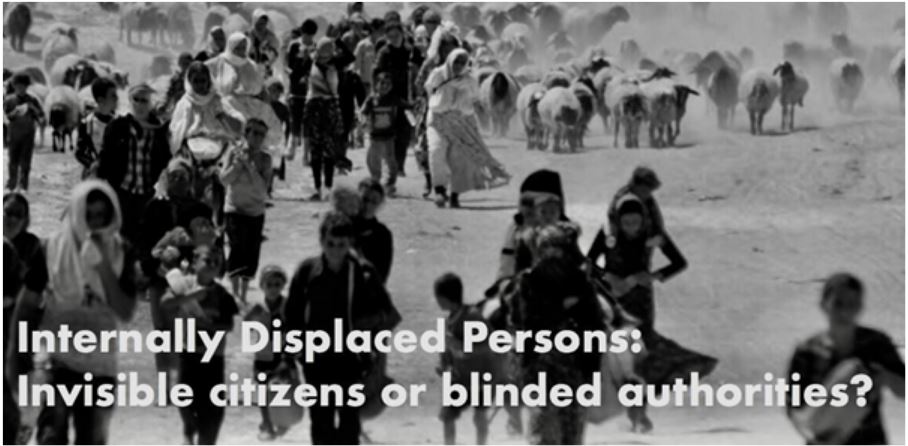UNSS, New York, July 2018
In support of the 20th anniversary of The Guiding principles on Internal Displacement, the United Nations Office for the Coordination of Humanitarian Affairs (OCHA) has launched the campaign #InvisibleCitizens, to humanize and draw global attention to internally displaced people (IDPs), an issue largely under-reported and virtually invisible in public media.
According to United Nations High Commissioner for Refugees (UNHCR), there are almost 70 milion forcibly displaced people worldwide. Among those, 40 million are Internally Displaced Persons (IDPs), people who are forced to flee their homes due to armed conflict, generalized violence, violations of human rights, natural or human-made disasters, but who remain within their own country. According to OCHA, more than 50 countries have people who have been internally displaced for a decade or longer.
People forced to flee or leave their homes -particularly in situations of armed conflict- suffer significantly higher rates of mortality than the general population, and are generally subject to increased vulnerability in a number of areas: high risk of physical attack, sexual assault and abduction, and are frequently deprived of adequate shelter, food and health services. The overwhelming majority are women and children whose basic rights are especially at risk of abuse; many children lose access to education, and are also at risk of sexual violence or forced recruitment into armed groups.
The governments of the states where IDPs are have the primary responsibility for their assistance and protection, as a critical element of sovereignty. The international community’s role is supposed to be complementary.
Internal displacement has been recognized as a global concern since the early 1990s. However, to this day, IDPs are not the subject of any international convention, do not have a dedicated UN agency working for them or any special status in international law. The term “internally displaced person” is merely descriptive, rather than a legal status: unless you cross an international border, you will not have access to the fundamental international protection mechanisms available to refugees and migrants.
Countries, UN agencies and Civil Society should face the issue, and policy frameworks and negotiations should be developed. To truly address internal displacement, the most affected countries must take the initiative to solve the issue. These countries are: Syrian Arab Republic (6,6 m.), Colombia (6,5 m.), Dem. Rep. of Congo (4,5 m.), Iraq (2,6 m.), Sudan (2 m.), Republic of Yemen (2 m.), South Sudan (1,9 m.), Nigeria (1,7 m.), Afghanistan (1,3 m.) and Turkey (1,1 m.). However, their obvious inability to address the issue should allow the UN to act in their stead.
In this regard, a Plan of Action was launched in Geneva at an event held by the Special Rapporteur on 17 April 2018, coinciding with the 20th anniversary of the “Guiding Principles on internal displacement” noted by UN Commission on Human Rights. This plan sets actions to achieve the goal of reducing and resolving internal displacement, and it will supposedly be carried out at the national, regional and global levels. A global GP20 campaign has also been set up to raise awareness of the global phenomenon of internal displacement.
However, only point 68 of the zero draft of the “global compact on refugees” mentions “Specific measures of support will often be required to avoid further displacement on return (internal or cross-border) and to ensure non-discrimination between returning refugees, the internally displaced, and non-displaced resident populations”. Footnote 47 also adds: “Countries of origin could also consider incorporation of the ‘Guiding principles on internal displacement’ in national laws and policies”. After 20 years of the Guiding Principles, with an alarming increase of IDPs, addressing and reducing this phenomena should be not just a footnote.
The Goal “Leave no-one behind”, included on the 2030 Agenda on Sustainable Development -adopted by 193 Governments- is like seeing light at the end of the tunnel, and authorities have an important role through policies on prevention, protection and solutions to displacement. Moreover, UN Secretary-General launched an Agenda for Humanity challenging the international community to halve internal displacement by 2030. Important steps has been reported in this sense, like in Colombia (National Development Plan aims to move 500,000 IDPs out of vulnerability by 2018), Somalia (the government has integrated internal displacement into its first National Development Plan, adopted in 2016) and Ukraine (the government recently created a Ministry for Temporarily Occupied Territories and Internally Displaced Persons).
It is now time to take the blindfold from our eyes: this should be the last opportunity to analyze what has been neglected in the past, and what states, international organizations, civil society, private sector and academia can do to improve the situation of IDPs in the future. For example, enforcing a new international legal frame protecting them, with the possibility to include sanctions to negligent governments. A system of UN independent Fact finding missions should be strengthened to analyze and monitor country by country the situation of the IDPs, with the aim of make recommendations to improve their situation. As example, the UN Myanmar mission recently has concluded the patterns of gross human rights violations and serious violations of international humanitarian law, amount to the gravest crime under international law, and called for the situation to be referred to international criminal court by the Security Council.
Internally displaced persons deserve a worthy future.


Very interesting article.
This is the harsh reality of this world.
You made a good point that the various organizations should move on from simply calling attention to the plight of IDPs and begin to punish violators of international human rights.
Perhaps its an unobtainable dream, but I hope this situation can be eradicated (as far as possible).
Peter.